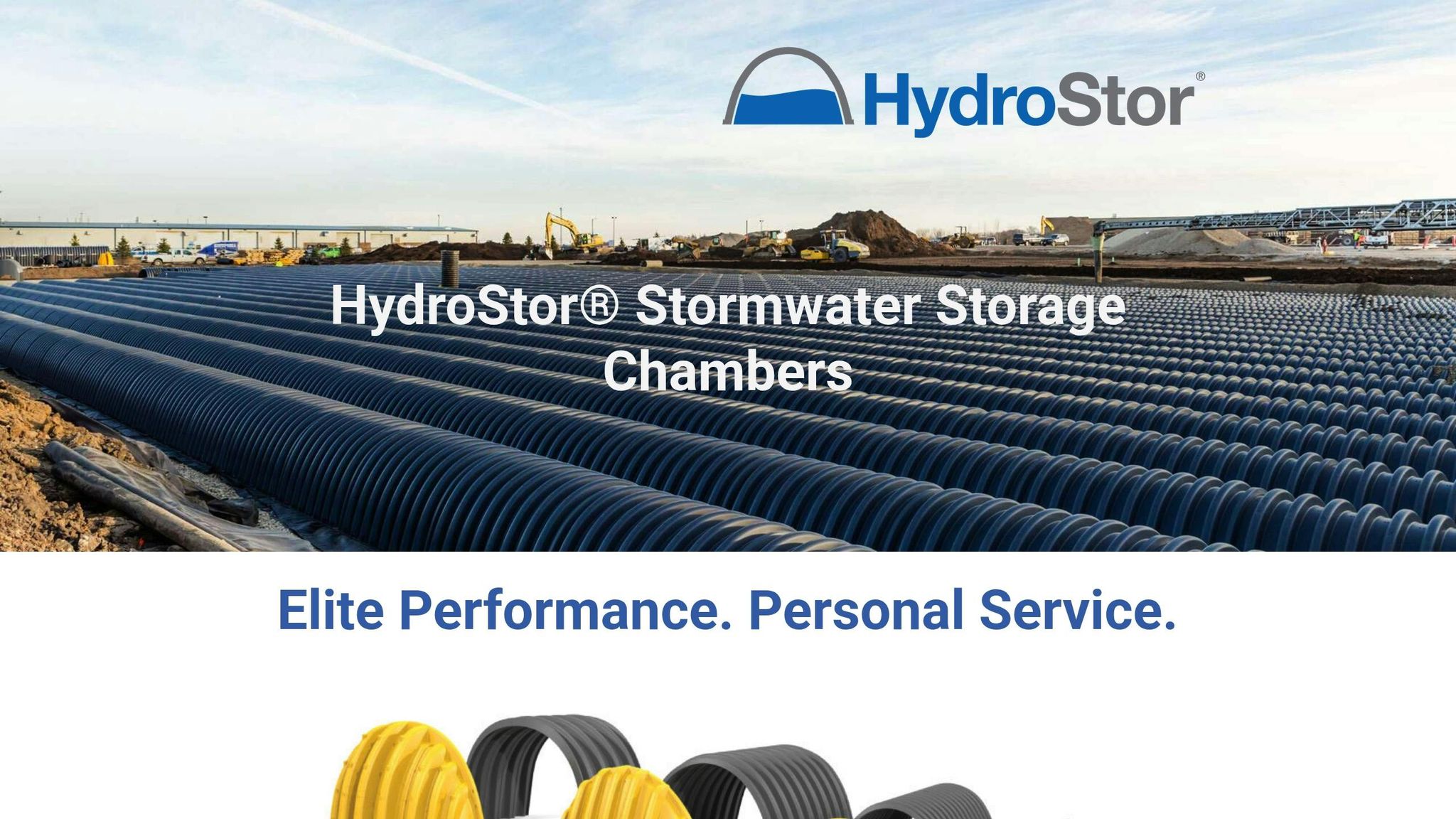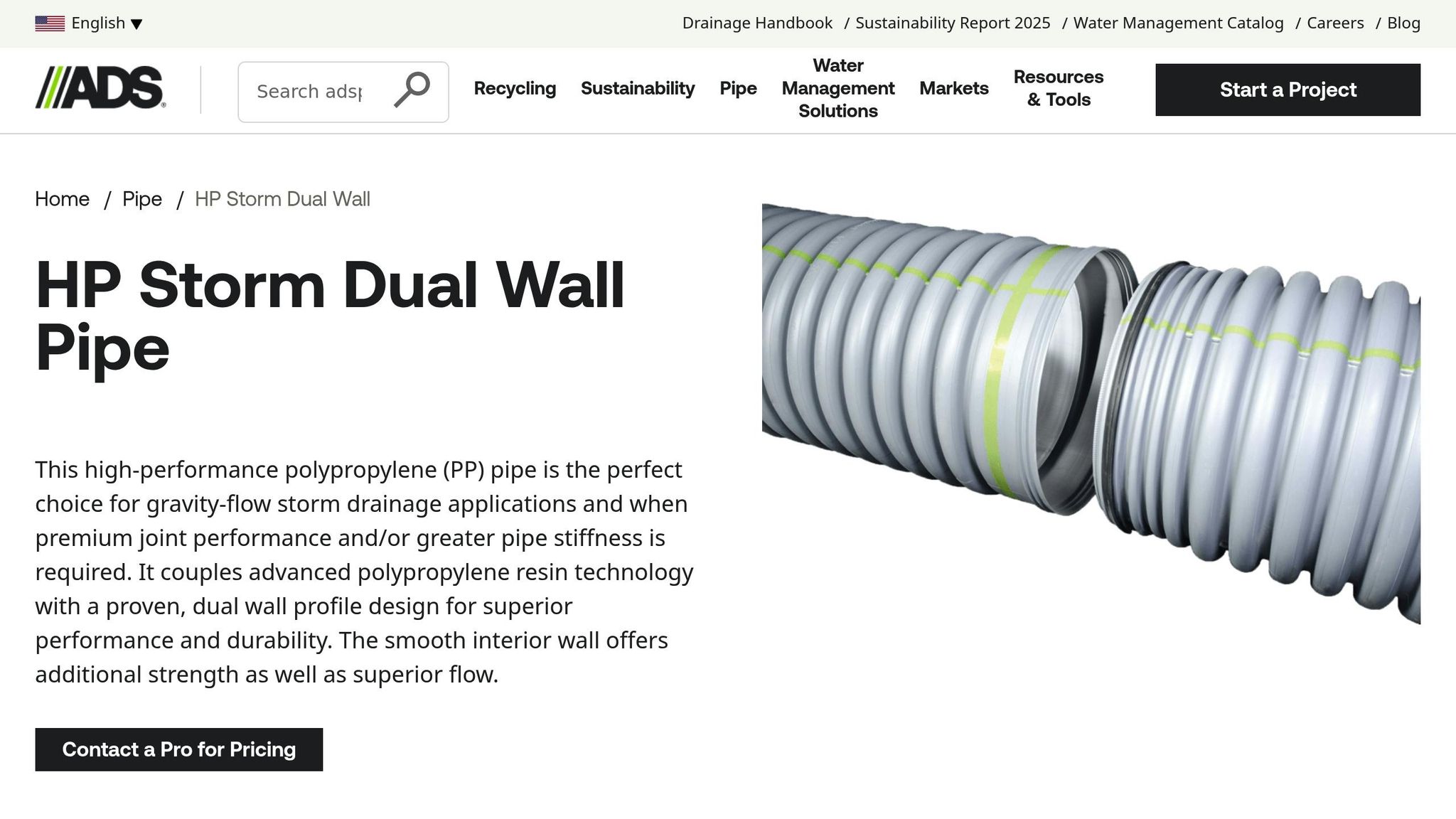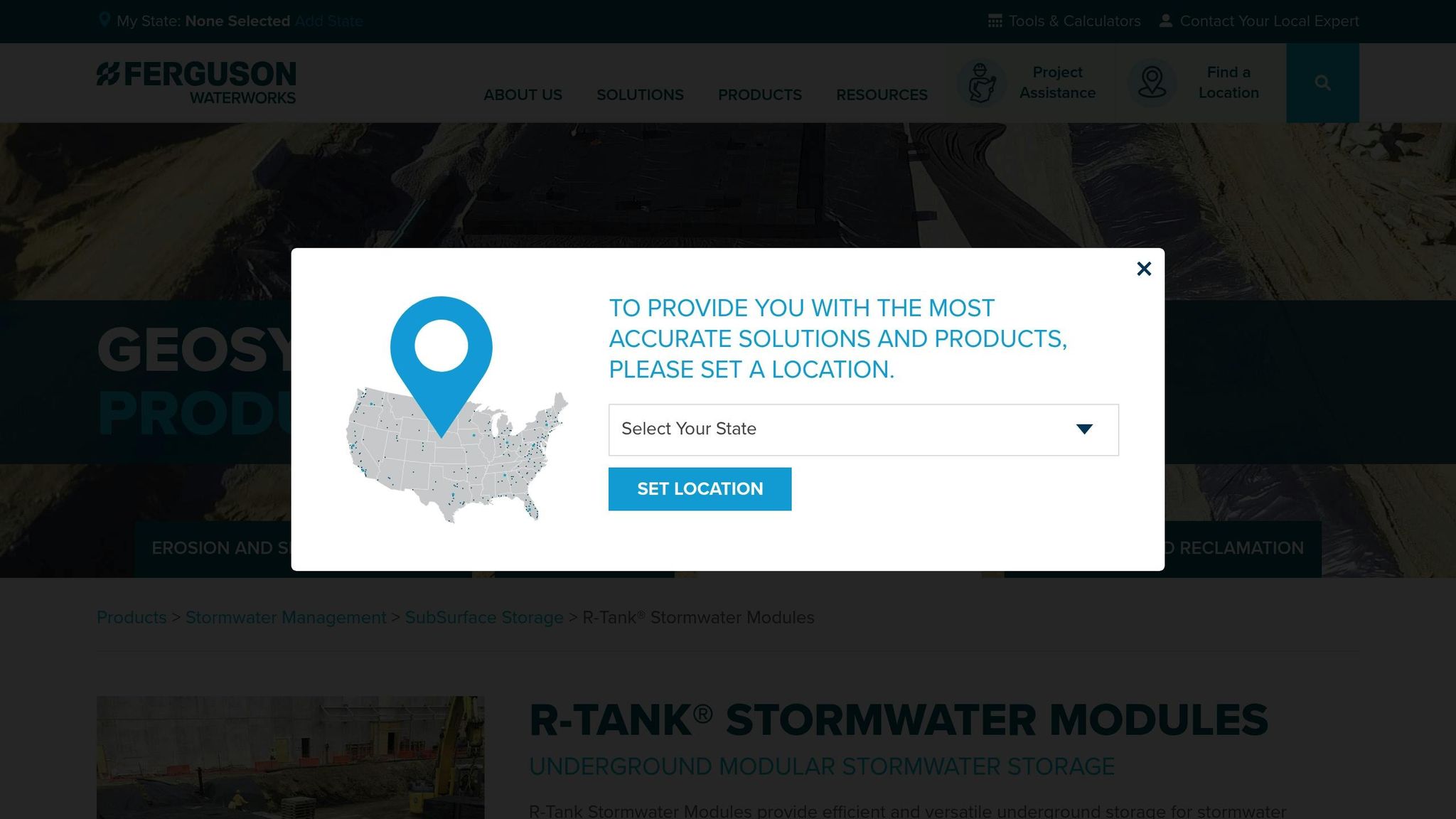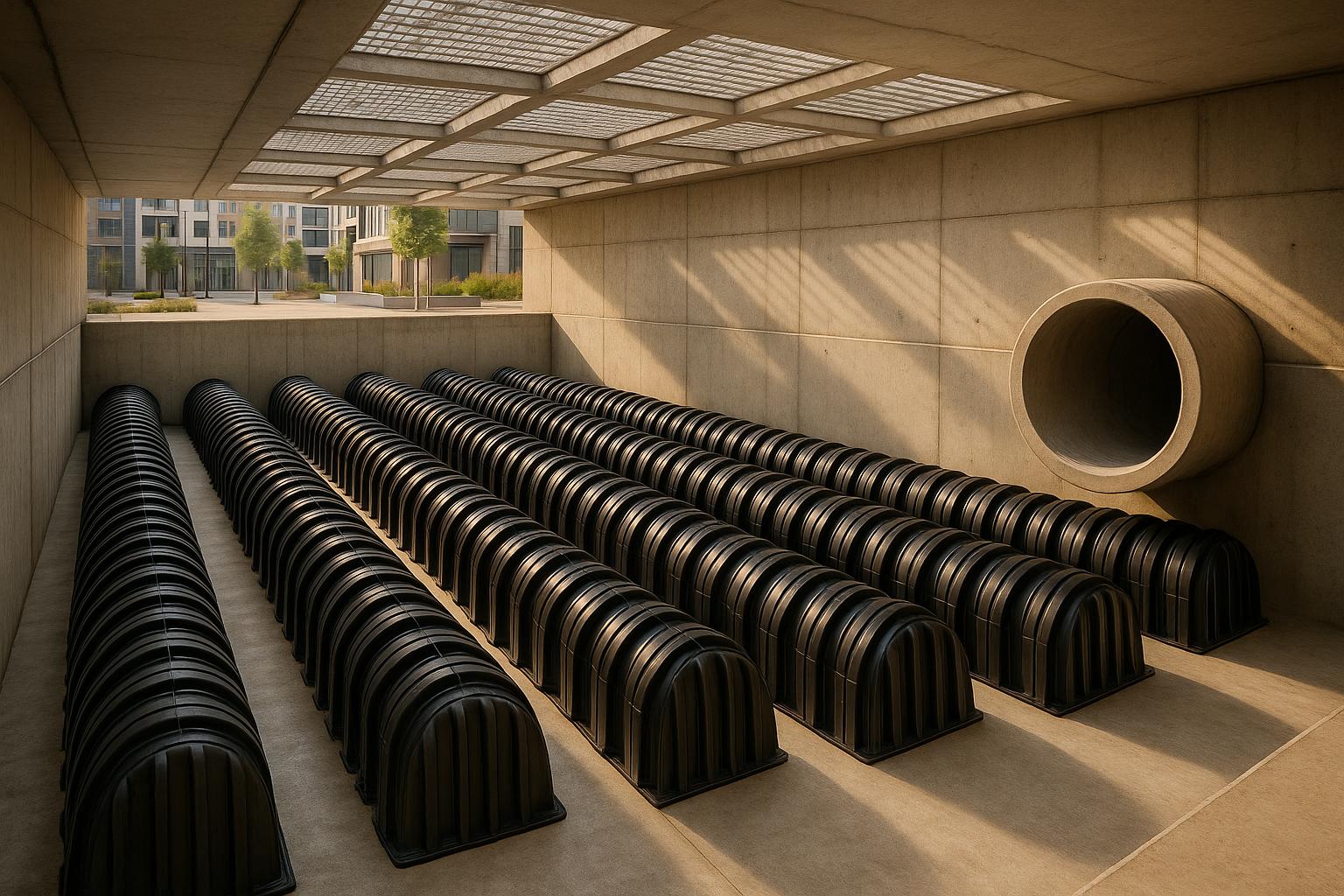- bhavya gada
- No Comments
In urban areas like Maryland, where space is limited and stormwater management is mandated, underground detention systems are essential. These systems manage runoff, reduce flooding, and improve water quality while allowing land above to be used for parking, buildings, or green spaces. Here’s a quick overview of five effective underground detention solutions:
- Advanced Modular Pipe Systems: Utilize large HDPE pipes for underground storage, offering flexibility in design and shallow installation depth.
- Precast Concrete Vaults: Pre-manufactured concrete structures that maximize water storage within small footprints and support heavy loads.
- Stormwater Chamber Systems: Arched chambers made of durable plastic, providing high storage with minimal excavation.
- Modular Crate/Block Systems: Interlocking modules that optimize vertical and horizontal storage, ideal for irregular spaces.
- Smart Detention Solutions: Combine traditional systems with technology like sensors and automation for real-time runoff management.
These systems cater to specific site needs, ensuring efficient stormwater control while maximizing land use. Below is a comparison to help you choose the right solution.
How Stormwater Chambers Work. HydroStor® Explained!

Quick Comparison
| System Type | Key Features | Installation Depth | Material Longevity | Maintenance Accessibility |
|---|---|---|---|---|
| Advanced Modular Pipes | Flexible layouts, HDPE pipes | Shallow | High | Easy |
| Precast Concrete Vaults | Heavy load support, compact design | Minimal cover | Very High | Easy |
| Stormwater Chambers | Arched design, plastic construction | Shallow | High | Easy |
| Modular Crate/Block Systems | Stackable, fits irregular spaces | Varies | High | Moderate |
| Smart Detention Solutions | Tech-enabled, dynamic water control | Varies | High | Remote monitoring |
Each system offers unique benefits tailored to land constraints, regulatory requirements, and long-term functionality. Choose based on your site’s needs and compliance goals.
1. Advanced Modular Pipe Systems (e.g., ADS HP Storm)

Advanced modular pipe systems are a practical solution for managing underground stormwater detention, offering both high capacity and adaptability. These systems use networks of large-diameter corrugated pipes to create substantial storage volumes below ground.
The ADS HP Storm system is a prime example of this approach. It features high-density polyethylene (HDPE) pipes that can be arranged in various layouts to suit specific project needs. Unlike traditional concrete systems, these modular designs can fit irregular site shapes and adjust as development requirements evolve. This adaptability also simplifies installation, guided by detailed cover and maintenance guidelines.
Installation Depth and Cover Requirements
ADS HP Storm systems are particularly suited for projects with limited space, thanks to their shallow cover requirements. For instance, pipes ranging from 12 to 48 inches in diameter need only one foot of cover in traffic areas (AASHTO H-20, H-25, or HL-93), while 60-inch pipes require 24 inches. This reduces the need for deep excavation and makes efficient use of underground space [1].
"The backfill envelope must be constructed in accordance with the Installation section (Section 5) of the Drainage Handbook and the requirements of ASTM D2321." [1]
Following these installation standards ensures the system performs consistently, even across Maryland’s diverse soil conditions.
Material Durability and Longevity
The HDPE construction of ADS HP Storm pipes offers durability that outperforms traditional materials like concrete. HDPE is resistant to corrosion caused by acidic soils and groundwater, making it ideal for Maryland’s varied climate and soil conditions. Additionally, the seamless design of these pipes prevents joint failures, reducing the risk of long-term maintenance issues and ensuring reliable performance for decades.
Maintenance Accessibility
Maintenance is straightforward with advanced modular pipe systems, thanks to their built-in access points. The large pipe diameters allow for easy entry during inspections, ensuring the system operates as intended. Smooth interior surfaces resist sediment buildup, making cleaning more efficient. Strategic placement of access points during installation further ensures that all components can be reached without requiring extensive excavation later on.
2. Precast Concrete Vault Systems (e.g., Retain-It)

Precast concrete vault systems, like Retain-It, offer a compact and efficient solution for underground stormwater detention. These vaults are manufactured off-site and delivered as complete systems, designed to optimize storage capacity within a small footprint while supporting heavy loads. This approach not only maximizes storage but also reduces the need for extensive excavation.
Storage Capacity per Square Foot
One of the standout features of these systems is their ability to minimize wasted excavation space. By focusing on efficient storage design, they allow for maximum stormwater detention without taking up excessive land. This efficiency can significantly lower excavation requirements, translating to notable cost savings during construction.
Installation Depth and Cover Requirements
Precast vault systems are engineered to require minimal cover for installation. This shallow installation capability is especially beneficial in urban areas, where excavation depth is often restricted, and preserving existing site features is a priority. The reduced cover requirements also contribute to long-term cost savings, making these systems a practical choice for urban developments.
Material Durability and Longevity
Constructed with engineered concrete, these vault systems are built to endure. They perform reliably under heavy loads and in tough environmental conditions, ensuring long-term functionality. Their robust construction minimizes maintenance needs, making them a solid option for stormwater management over the years.
Maintenance Accessibility
Maintenance is straightforward with precast concrete vaults, thanks to their thoughtful design. Built-in access features, such as large hatches and an open interior layout, simplify routine inspections and cleaning. This ease of access helps property owners manage sediment removal efficiently, ensuring compliance with local stormwater regulations while reducing ongoing maintenance efforts.
3. Stormwater Chamber Systems (e.g., StormTech Arched Chambers)

Stormwater chamber systems are a smart choice for managing stormwater detention underground. By using arched plastic chambers, these systems provide high storage capacity with less excavation. StormTech chambers, made from durable plastics, combine strength with space-saving efficiency. Their design allows for maximum underground storage while keeping the surface area free for other uses.
"The StormTech® underground stormwater arch chamber system is known as one of the most revolutionary engineered stormwater management solutions on the market… Its structural durability can handle heavy loads and offers an impressive 75-year design life." – Titan Environmental [2]
Storage Capacity per Square Foot
The unique arched shape of these chambers ensures they make the most of the available space. By optimizing every cubic foot within the excavated area, they help property owners meet detention requirements with smaller excavation zones. This not only cuts construction costs but also minimizes site disruption. Plus, the chambers can be arranged in various layouts to fit irregular site shapes, all while maintaining effective storage capacity.
Installation Depth and Cover Requirements
StormTech chambers are engineered for reliable performance even with shallow cover. Their structural design spreads loads evenly across the arch, preventing weak points that could fail. Tested under AASHTO Design Truck H20 specifications, these chambers can be installed under parking lots, driveways, or roads without sacrificing durability or function [3]. This makes them especially suitable for urban settings where space and excavation depth are limited.
Material Durability and Longevity
These chambers are built to last. Made from injection-molded ASTM resins, they resist underground pressures and environmental wear.
"StormTech chambers are typically made from durable materials like high-density polyethylene (HDPE), which is resistant to chemicals and environmental stress. They have a designed lifespan of over 50 years with proper maintenance, making them a long-lasting solution for stormwater management." – Resolute Civils [4]
With a 75-year design life validated through rigorous load testing, these chambers are a dependable, long-term solution for stormwater management [2][3].
sbb-itb-843f8be
4. Modular Crate/Block Systems (e.g., R-Tank)

Modular crate and block systems, like the R-Tank, offer a smart, space-efficient solution for stormwater detention. These systems use interlocking plastic or concrete modules to create a flexible storage network. Unlike traditional fixed-size chambers or pipes, modular systems can be tailored to fit irregular spaces and meet specific capacity requirements. The interlocking design forms a continuous storage structure that can navigate around utilities and other site constraints. This makes them especially valuable in urban areas where space is tight. Additionally, their ability to optimize vertical and horizontal storage ensures maximum capacity in limited spaces.
Storage Capacity and Vertical Optimization
One of the standout features of modular crate systems is their ability to maximize water storage by minimizing wasted space. Their stackable design allows for vertical expansion, meaning multiple layers can be installed to significantly increase capacity without taking up additional ground area. To assist with planning, a design tool is available to calculate exact storage needs.
Installation Considerations
These systems are versatile enough to work in various installation conditions. It’s essential to follow the manufacturer’s recommendations regarding cover depth, load distribution, and compliance with local codes to ensure proper performance.
Durability and Maintenance
High-quality modular systems are built with tough materials designed to withstand underground environments. If maintenance is needed, individual units can be easily replaced, and the design allows for straightforward cleaning. By maximizing storage while minimizing space requirements, modular crate systems continue to be a practical and efficient option for managing stormwater in urban settings.
5. Smart Detention Solutions
Smart detention solutions are a step forward in underground stormwater management, blending traditional storage systems with modern technology like sensors, automation, and data analytics. These solutions take the efficiency and functionality of conventional systems to the next level, making them especially valuable in urban environments where space is limited [5][7].
One of the standout features of these systems is their ability to manage storage dynamically. By adjusting outflow rates based on factors like rainfall predictions, current storage levels, and downstream capacity, they can handle multiple storm events within the same physical space. This adaptability is a game-changer for areas where maximizing land use is critical.
Storage Capacity per Square Foot
Smart detention systems are designed to make the most of their underground storage volume. With up to 95% void space, nearly every inch of the system’s structure is available for water storage [8]. Intelligent controls further enhance this capacity by managing inflow and outflow in real time. For example, these systems can release stored water between storms, effectively resetting their capacity without needing additional physical space [5][6]. This means a single system can handle multiple storm events, making it incredibly efficient.
Installation Depth and Cover Requirements
These systems offer the same flexibility as conventional underground solutions but with added intelligence. Cover depths typically range from 12 inches to 10 feet, depending on the materials used and the expected surface loads [8]. Designed to support heavy traffic loads like HS‑20/HS‑25, they can be installed under roads, parking lots, or landscaped areas. The integration of smart controls requires minimal additional infrastructure, as access points are usually incorporated into the existing system [6][7].
Material Durability and Longevity
The durability of smart detention systems is built on the strength of their structural materials and the reliability of their technological components. High-density polyethylene and reinforced concrete provide a solid foundation, ensuring the system can endure decades of use and heavy vehicular loads [8][9]. The sensors and control systems are designed to withstand harsh weather conditions, ensuring the technology remains functional over the long term.
Maintenance Accessibility
These systems are not only durable but also designed for straightforward maintenance. Remote monitoring and automated alerts make it easy to identify potential issues quickly [5][7]. Property owners can receive updates on water levels, system status, and maintenance needs in real time. The modular design simplifies inspections and cleaning, with components that are easy to access or replace. However, the electronic components may require specialized maintenance, such as periodic calibration or part replacements. User-friendly interfaces help streamline these tasks, making routine upkeep more manageable.
For property owners in central Maryland and Washington, DC, Pro Landscapes MD offers expertise in installing and maintaining smart detention systems. Their experience in advanced stormwater management ensures your system will be seamlessly integrated into your project and perform reliably over time.
System Comparison Chart
In urban areas where space is tight, making the most of storage capacity is essential. The chart below gives a quick look at how different underground detention systems perform in terms of efficiency. Choosing the right system often comes down to how much storage it can offer. For instance, precast concrete vaults and modular crate/block systems can hold tens of thousands of cubic feet, while stormwater chamber systems typically manage around 13,018 cubic feet per basin, as seen in the Lyman Terrace Revitalization Project.
| System Type | Storage Capacity Description |
|---|---|
| Advanced Modular Pipe Systems | Varies depending on design |
| Precast Concrete Vault Systems | Offers high storage capacity |
| Stormwater Chamber Systems | Around 13,018 cubic feet per basin (Lyman Terrace Project) |
| Modular Crate/Block Systems | Delivers high storage capacity |
| Smart Detention Solutions | Adjusts storage dynamically using smart technology |
This chart underscores the efficiency of each system in optimizing storage within confined underground spaces.
If you’re a property owner in central Maryland or Washington, DC, reach out to Pro Landscapes MD for expert advice on choosing the best detention system for your needs.
Conclusion
Underground detention systems provide smart solutions for property owners dealing with limited space and stormwater management needs. By utilizing underground storage, these systems free up surface space for other uses, making them especially practical for urban and suburban areas where every square foot counts.
The five systems discussed each offer unique benefits, allowing for customization based on specific project needs and site conditions. However, proper installation is crucial. Aligning with regional standards and considering factors like soil conditions and local regulations ensures the system performs efficiently and avoids costly mistakes.
For property owners in central Maryland and Washington, DC, Pro Landscapes MD offers unmatched expertise in stormwater management. Their services cover everything from grading and drainage installation to seamlessly integrating detention systems into your landscape. With a thorough understanding of local requirements, they’ll guide you through every step, from choosing the right system to completing the installation.
Choosing the right detention system now not only protects your property but also makes the most of your available space for years to come.
FAQs
How can I choose the right underground detention system for my property?
When deciding on an underground detention system, several factors come into play. Start by assessing the space available on your property, the soil conditions, and the specific stormwater management requirements. Pay close attention to the system’s storage capacity, how well it works with your soil’s permeability, and its ability to manage water flow and discharge rates efficiently.
You’ll also need to choose the right type of system – whether it’s pipes, tanks, or vaults – and ensure it integrates seamlessly with your existing infrastructure. A well-thought-out design that balances performance, cost, and site limitations is key to achieving effective and dependable stormwater management for your property.
What kind of maintenance do underground detention systems need, and how durable are they over time?
Underground detention systems require consistent maintenance to function effectively and last as long as possible. It’s recommended to inspect these systems at least once a year and after significant rainstorms. These inspections help identify issues like debris, sediment buildup, or structural damage. Cleaning is generally needed every 1 to 3 years, especially if sediment has reduced the system’s capacity by over 25%.
The lifespan of these systems heavily relies on the use of durable materials and regular upkeep. Routine maintenance not only prevents structural problems but also ensures the system continues to perform efficiently over time.
Can advanced detention systems be added to existing stormwater setups, and what are the advantages?
Advanced detention systems can easily blend into current stormwater management setups, bringing a range of benefits. These systems leverage smart technology to adapt to rainfall in real-time, helping to regulate water flow, lower the risk of flooding, and filter out pollutants to improve water quality.
By incorporating underground storage, they free up surface space, enhance safety, and keep the environment clean and visually appealing. Additionally, they assist in meeting regulatory requirements, potentially cutting costs and streamlining stormwater management operations.


















Chat with Us